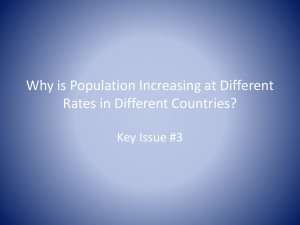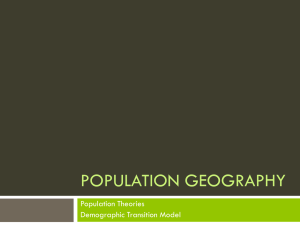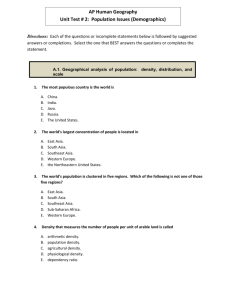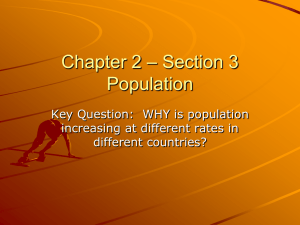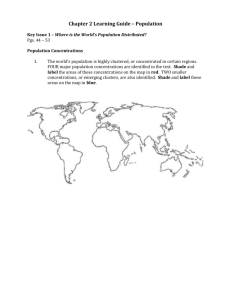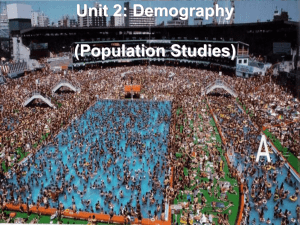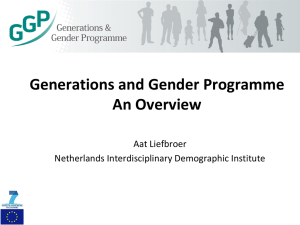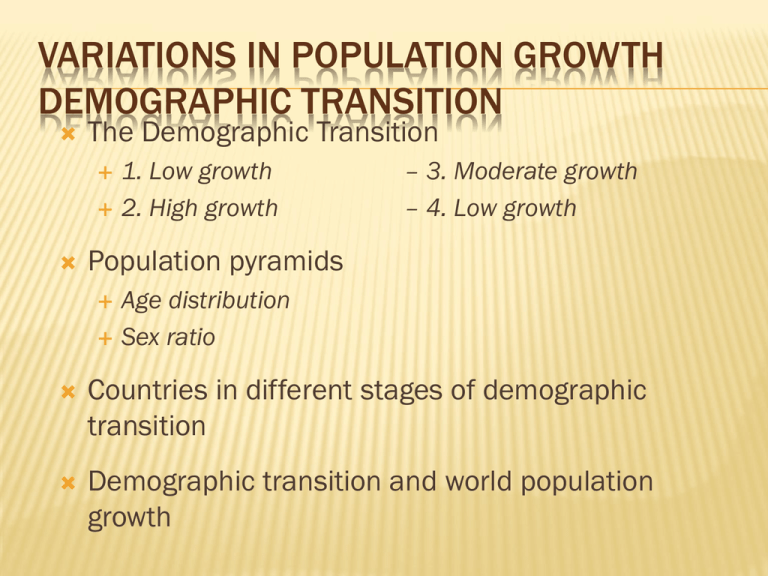
VARIATIONS IN POPULATION GROWTH
DEMOGRAPHIC TRANSITION
The Demographic Transition
1. Low growth
2. High growth
– 3. Moderate growth
– 4. Low growth
Population pyramids
Age distribution
Sex ratio
Countries in different stages of demographic
transition
Demographic transition and world population
growth
WORLD POPULATION & GROWTH
RATES, 400,000 BC - AD 2000
Demographic transition – The changes in
natural increase caused by shifts in birth
and death rates in a given area of the Earth.
THE DEMOGRAPHIC TRANSITION
Fig. 2-13: The demographic transition consists of four stages, which move from high
birth and death rates, to declines first in death rates then in birth rates, and
finally to a stage of low birth and death rates. Population growth is most
rapid in the second stage.
DEMOGRAPHIC TRANSITION MODEL
1) Most of our time on Earth
2) High birth and high death rates
NIR is around 0 with population of
world around ½ million
3) Food is unpredictable
4) Despite beginning of human settlement,
war and disease balance out high birth
rates (families depend on children for
farming)
Low
Growth
Present Day: No countries here
Low
Growth
1) CBR declines to the point where it
equal CDR
2) NIR approaches zero (Zero Population
Growth or ZPG)
3) TFR falls beneath the 2.1 replacement
rate
4) Women enter the workforce, more
access to birth control methods, more
leisure/entertainment time
Present Day: Much of Europe, Russia as
example
1) Industrial Revolution in England and North
America (1750-1800)
2) High Birth and decreasing death rates
3) 10x faster growth
4) Stabilization of food supply, improvement
of sanitation techniques, and creation of
wealth through technology and invention
High
Growth
Present day: 1950 – most of
Africa, Asia , Lat. Am.
Moderate
Growth
1) CBR drops, but still is higher
than CDR;
- CDR continues to decline, but at a
slower rate
2) CBR declines due to changes in customs,
people choose to have fewer children
because of changes in female roles, jobs in
service/urban areas
Present Day: Beginning of 20th century•Stage 5?
Europe and North America, most of Asia
•High CDR and
and Latin America by end of 20th century
irreversible
population decline
1) Most of our time on Earth
2) High birth and high death rates
NIR is around 0 with population of world around ½ million
3) Food is unpredictable
4) Despite beginning of human settlement, war and disease balance out high birth rates
(families depend on children for farming)
Present Day: No countries here
Back
1) Industrial Revolution in England and North America (1750-1800)
2) High Birth and decreasing death rates
3) 10x faster growth
4) Stabilization of food supply, improvement of sanitation techniques, and creation of wealth through
technology and invention
Present day: 1950 – most of Africa, Asia , Lat. Am.
Back
1) CBR drops, but still is higher than CDR;
- CDR continues to decline, but at a slower rate
2) CBR declines due to changes in customs, people choose to have fewer children because of
changes in female roles, jobs in service/urban areas
Present Day: Beginning of 20th century Europe and North America, most of Asia and Latin
America by end of 20th century
Back
1)
2)
3)
4)
CBR declines to the point where it equal CDR
NIR approaches zero (Zero Population Growth or ZPG)
TFR falls beneath the 2.1 replacement rate
Women enter the workforce, more access to birth control methods, more leisure/entertainment
time
Present Day: Much of Europe, Russia as example
Back
DEMOGRAPHIC TRANSITION IN ENGLAND
Low growth until 1750 –
bubonic plague causes a decline
as does famine, bad harvests
High growth 1750—1880
industrial revolution food supply
is more stable, money though
industrial employment
Moderate growth 1880-1970s –
Low growth now now has 50
million vs 6 mil in 1st stage
Fig. 2-14: England was one of the first countries to experience rapid population growth in
the mid-eighteenth century, when it entered stage 2 of the demographic
transition.
BASIC PATTERNS OF
POPULATION GROWTH
Stage of demo transition gives it a
specific shape
Mostly determined by the CBR
Dependency ratio-the number of
people who are too young or too old
to work compared to the number of
people in their productive years –
usually divided into 3 groups 0-14,
15-64, 65 older
Stage 2 1 worker for every
dependent, stage 4 2 workers for
every 1 dependent
Elderly percentage increases as you
move through the stages
Stage 4 countries have higher cdrs
because population is older
PERCENT OF POPULATION UNDER 15
1/3rd of the world population is
under 15
Sex ratio – number of males
/100 females; more males than
females are born, but men die
earlier in Europe/NA 95/100
rest of the world 102/100, in US
males under 15 exceed females
105/100 – women start
outnumbering men around age
40 by 65 women are 58%
In LDCs high maternal death
rates cause the figure to be
skewed
ELDERLY POPULATION
POPULATION PYRAMIDS IN U.S. CITIES
Fig. 2-16: Population pyramids can vary greatly with different fertility rates (Laredo vs.
Honolulu), or among military bases (Unalaska), college towns (Lawrence), and
retirement communities (Naples).
RAPID GROWTH IN CAPE VERDE
12 small islands off
coast of west africa
Colony of portugal until
1975
Moved from 1-2 in
1950
Many famines
Pop has tripled, natural
Fig. 2-17: Cape Verde, which entered stage 2 of the demographic transition in about
is 3%history
1950, is experiencing rapid populationincrease
growth. Its population
reflects the impacts of famines and out-migration.
MODERATE GROWTH IN CHILE
Moved from rural to urban
Many still prefer large families
Was still stage 1 as of 1900
Most pop increase is from
immigration
1930s move to stage 2 –
medical tech; stage 3 since
1960s –vigourous government
family planning, high
unemployment rates; govt
reversed its policy
Fig. 2-18: Chile entered stage 2 of the demographic transition in the
1930s, and it entered stage 3 in the 1960s.
LOW GROWTH IN DENMARK
Stage 4
Zpg
Increasing # of elderly
raises cdr
Fig. 2-19: Denmark has been in stage 4 of the demographic transition
since the 1970s, with little population growth since then. Its
population pyramid shows increasing numbers of elderly and
few children.
CENSUS TAKING IN CHINA
Information for pop pyramids is
obtained through census taking
Most countries are in 2 and 3
stage – rapid growth/moderate
growth
2 things impacting the model
today – tech innovation has
diffused throughout the world
which drops cdr, cbr continues
to increase bc social customs
have not changed
19th c change in cdr due to
industiral revolution; drop in cdr
in other places due to diffusion
of this tech

